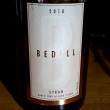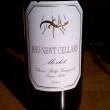Paumanok Vineyards Protecting Consumers Against Counterfeit Wines
By Lenn Thompson, Editor and Publisher
 Today, Paumanok Vineyards and Applied DNA Sciences announced a partnership created with the goal of protecting consumers against the growing problem of counterfeit wines.
Today, Paumanok Vineyards and Applied DNA Sciences announced a partnership created with the goal of protecting consumers against the growing problem of counterfeit wines.
From the press release:
"Counterfeiting is a problem known to have a significant impact in the wine and spirits trade," said Applied DNA Sciences CEO James Hayward. “We are delighted to be working with Paumanok to ensure that their products continue to be enjoyed and valued by retailers and consumers.”
"Paumanok, wines are highly valued around the country due to high demand and limited availability," said Charles Massoud, Proprietor, Paumanok. "The problem of counterfeiting has become more prolific worldwide. Authenticity definitely matters and our new wines will have a unique label that can be authenticated. We are proactively doing everything we can to ensure, from vine to bottle, that the Paumanok name represents exceptional quality."
The Massoud family feels that "guaranteeing quality wines helps small wineries to be competitive in today’s market."
They've designed new labels, which include Applied DNA Sciences botanical SigNature DNA markers. These labels will initially be used for the launch of Paumanok's newly released 2008 Late Harvest Riesling, 2007 Tuthills Lane Vineyard Merlot (due out in late 2009) and 2007 Apollo Drive Vineyard Petit Verdot (due out in 2010). Apparently, SigNature DNA is a botanical mark that can be added to ink and used to authenticate products in a unique manner that essentially cannot be copied. Maybe a scientist out there can tell me a bit more about it?
I emailed with Charles this morning about this, asking him if they've had to deal any instances of counterfeit Paumanok Vineyards wines. He told me "While we have not had, to our knowledge, such an incident, there have been, as you know, many documented instances of such fraud. We have used Signature DNA on our most expensive wines for now, but eventually, because it is a non-intrusive
authentication device, we would like to include it in all our labels.
It is an additional measure to protect the consumer and our brand. And given that Applied DNA is another Suffolk County-based business, we liked the idea of being with them at the forefront of innovation."
Paumanok was the first local winery to convert part of their bottling to screwcap closures (others have since invested in the equipment). Maybe they'll be the first again with this technology, though I'm not sure that many local wineries consider fraud a problem.
They probably wish there wines were in enough demand that that were the case.














This seems like (and correct me if I am wrong) it only affects the label. So it would not stop someone from using a Paumanok bottle and filling it with something else?
From what I read about this (mostly on business-related sites, not very high-level sciencey stuff), the process seems to be as follows.
(1) Paumanok gives juice or wine or cuttings or some other biological material to ADS.
(2) ADS amplifies a piece of the DNA from the grapes by PCR (polymerase chain reaction) and incorporates it into specially-made ink to be placed on the label
(3) Should the product need to be identified, there are three increasingly stringent levels of identification:
(a) is the special ink there? (UV-light detection, probably, requires a UV light) cost: $
(b) is the DNA we think should be there actually there? (take some ink & amplify the DNA by PCR, requires science) cost: $$$
(c) is the DNA that is there EXACTLY the DNA that we think it is? (PCR, followed by restriction digest of the DNA, or sequencing) cost: $$$$-$$$$$
DNA is can be thought of as a chain of letters: A, T, C, and G. Restriction enzymes cut DNA at certain base-pair sequences (think “words” in this analogy, e.g., CATATG). These sequences appear at different places in every piece of DNA. When DNA is digested with restriction enzymes, it creates pieces of varying lengths depending on the location of the cut sites.
example, where X is the cut site:
===X========X=====X==X= becomes === ======== ===== == =
=X===X====X============ becomes = === ==== ============
An analysis (gel electrophoresis, specifically) can then be performed where a unique pattern of sizes emerges, which you can compare to the original DNA sample. This is also how they do paternity tests and CSI-type forensic analysis.
Sequencing is the process of chemically “reading” the DNA’s pattern, and is the most accurate way of ascertaining authenticity in this case.
So, low level authentication (like the marker you use to authenticate a $50 or $100 bill) is easy, but doesn’t really involve the DNA itself. The DNA in the ink can be amplified easily and analyzed to determine authenticity. Additionally, faking DNA to this level (e.g., synthesizing pieces of DNA that will stand up to scrutiny) is extremely cost-prohibitive and bafflingly complex. I’m not sure how much DNA is actually in finished wine (especially because DNA is not that soluble in ethanol) so I am not sure if they can actually sample what is in the bottle.
According to some research, DNA can be measured in wines up to 6 months in the bottle, so it’s possible that you could compare the actual product to the label.
Just speculating though. I’m sure the actual DNA sequences and technology are closely protected.